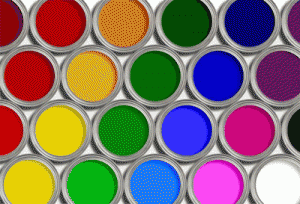
Maybe you’ve created your own custom color for your interior painting project from paints lying around the basement, only to find that you can’t figure out how to replicate it. Or perhaps you moved into an Athens home with a paint color scheme that you love, but it needs some touching up. You head over to your local paint store and come home armed with a pocketful of paint chips, thinking surely one of the colors will match, but no luck. Who knew there were so many different shades of green?
As we learned from our big box of Crayolas, purple isn’t just purple and red isn’t just red. You can choose from cornflower blue, midnight blue, blue-gray, blue-green and the list goes on. Colors are actually waves of light, and each wavelength has a value that makes it different from the rest. A color can be described by how pure or desaturated it is, as well as its value or lightness. So describing something as green or even blue-green isn’t going to be specific enough if you’re trying to find the exact color. There could even be 10 different shades of blue-green. So how could you possibly expect to find that color you’re looking for?
Fear not, because your perfect match is out there. And the machine that can find it is called a spectrophotometer. Spectrophotometers have been used in the auto industry for years to seamlessly touch up that cherry paint job, and fortunately for paint consumers, they’re now common at paint stores. The best part is that the service is usually free. Your Athens painting contractor will use a spectrophotometer to match your paint color when completing an interior painting project for you.
To properly understand how a spectrophotometer works, we first need to understand how color works. This is a broad topic, so for our purposes, we’ll do a brief overview. Color is made up of wavelengths of light and can be broken into six categories:
As you can see, visible light is somewhere in the middle, and this is what the spectrophotometer analyzes to match paint. The visible light spectrum is composed of good ol’ ROY G. BIV, which is an acronym for red, orange, yellow, green, blue, indigo and violet. These seven colors make up all the different colors we can see with the naked eye. Black is the absence of color, and white is made up of all of these colors. This will come into play in a minute.
A spectrophotometer is actually a pretty simple piece of machinery, about the size of a shoe box. The basic components of a spectrophotometer are:
Because it’s made up of all of the colors in the visible spectrum, white light is the illumination source used in a spectrophotometer, in the form of a tungsten bulb or in more advanced models, a Light Emitting Diode (LED). A clip located on the outside of the machine holds the paint sample to be matched, and white light is flooded onto the sample. This light is reflected off the sample back into the machine and onto a small wheel. The wheel is a highly efficient color analyzer, consisting of a number of interference filters and powered by a stepper motor, which is known for its precision.
Visible light is measured in nanometers, which is a tiny unit of measurement in the metric system, equal to one-billionth of a meter. Each filter is programmed to allow a specific wavelength of light to pass through it, and each wavelength is within a particular range of nanometers. The visible light spectrum ranges from the reds at 400 nm to the blues in the 700nm range, and the most efficient wheels have filters that handle intervals of 10 nm each.
Earlier spectrophotometers used transmission filters, which meant the wavelength that matched the color sample would be reflected through the filter, and all of the other wavelengths would be absorbed. An example of this is if you were to shine a white light on a red apple. The apple will absorb all of the other colors, but will reflect red back to you.
Nowadays, spectrophotometers in paint matching use interference filters, where only the color of the sample reaches the filters — all other wavelengths are reflected away. This increases the accuracy of matching the sample because absorption can interfere with readings. The wavelength representing the correct color match passes through the correct filter and is then picked up with fiber optics and piped to a photo diode. The photo diode converts the information to an electronic signal, which is then sent to computer software that formulates the exact amount of pigments needed to make the match. And that’s how ya do it, folks.
Though the technology may seem complicated, the process of using a spectrophotometer is not. It’s hooked up to a touch screen computer monitor that asks all the questions, making the process user-friendly for the operator. You pick your paint base, and if you want the best match, it’s wise to steer clear of the cheap stuff. Mid-grade and high-grade paint work best.
These machines are pretty adept at matching colors from a variety of sources, though the best matches happen with samples that don’t have much texture or sheen. For example, glossy magazine clippings can cause a glare, and a busy wallpaper pattern or a high pile carpet present challenges in detecting the true color. Photos aren’t great either because the colors aren’t precise.